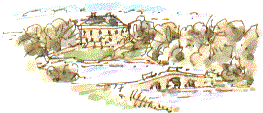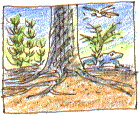Nature Diary
Rocks
History
Gallery
Links
Home Page
 SHARLSTON HALL (5 miles west of Wakefield) is timber on stone foundations, dating from the 1300ís. There is a story that an Earl of Westmorland asked for accommodation from the Stringer
family and subsequently married the Stringer heiress. The house became the residence of the estate bailiffs. It was restored after colliery subsidence.
SHARLSTON HALL (5 miles west of Wakefield) is timber on stone foundations, dating from the 1300ís. There is a story that an Earl of Westmorland asked for accommodation from the Stringer
family and subsequently married the Stringer heiress. The house became the residence of the estate bailiffs. It was restored after colliery subsidence.
The dovecote gave the residents the advantage of fresh meat in the winter period. The gateposts are late 17th to early 18th century.
 Foulby was the childhood home of John Harrison (1693-1776), who was baptised in the neighbouring village of Wragby. As the best-selling book Longitude explains, it was Harrison who built a clock to enable longitude to be calculated. His marine chronometer included apparatus
to cope with variations in climate and the motion of the ship. On a trial voyage to Jamaica (1761-62) his chronometer gave a longitude accurate to within 18 miles.
Foulby was the childhood home of John Harrison (1693-1776), who was baptised in the neighbouring village of Wragby. As the best-selling book Longitude explains, it was Harrison who built a clock to enable longitude to be calculated. His marine chronometer included apparatus
to cope with variations in climate and the motion of the ship. On a trial voyage to Jamaica (1761-62) his chronometer gave a longitude accurate to within 18 miles.
Nostell
 The A638 road from Wakefield to Doncaster was one of the first toll roads, opened in 1741 and taking tolls until the 1870s. The bridge over Nostell Lakes dates back to the time of this toll road.
The A638 road from Wakefield to Doncaster was one of the first toll roads, opened in 1741 and taking tolls until the 1870s. The bridge over Nostell Lakes dates back to the time of this toll road.
 At the upper end of the lakes, a newly landscaped area, once the site of Nostell Colliery, has been maturing over the past two years. Most of the trees, planted as whips, are still no more than knee-high. The small oval lake is as yet devoid fringing vegetation. Following the broad curving shale paths across gently sloping contours is like stepping onto a landscape designer's ground plan. A pair of Mute Swans look rather lonely with the lake to themselves. They swim over towards us and the cob gives us his thick-neck, wings raised threat display.
At the upper end of the lakes, a newly landscaped area, once the site of Nostell Colliery, has been maturing over the past two years. Most of the trees, planted as whips, are still no more than knee-high. The small oval lake is as yet devoid fringing vegetation. Following the broad curving shale paths across gently sloping contours is like stepping onto a landscape designer's ground plan. A pair of Mute Swans look rather lonely with the lake to themselves. They swim over towards us and the cob gives us his thick-neck, wings raised threat display.
  The only other bird on this windswept site is one with white stripes on its tail, hopping along in the drainage channel ahead of me. I assume that it is a wagtail, but when it flies off I see that it is a Meadow Pipit. It has a bouncing flight and a quiet twittering call that doesn't really sound like 'pi - pit!'.
The only other bird on this windswept site is one with white stripes on its tail, hopping along in the drainage channel ahead of me. I assume that it is a wagtail, but when it flies off I see that it is a Meadow Pipit. It has a bouncing flight and a quiet twittering call that doesn't really sound like 'pi - pit!'.

 The side-lighting of the low afternoon sun is perfect for picking out fossils amongst the fragments of red shale, which 300 million years ago, at the time of the Coal Swamps was dark mud. The fine striations (above left) are a cast from the hollow stem of Calamites the giant horsetail, while the broader stripes (right) may be the bark, made up of a pattern of old leaf scars, of one of the Giant Club Mosses, such as Sigillaria, which grew to height of tens of metres in the dense tropical coal forests.
The side-lighting of the low afternoon sun is perfect for picking out fossils amongst the fragments of red shale, which 300 million years ago, at the time of the Coal Swamps was dark mud. The fine striations (above left) are a cast from the hollow stem of Calamites the giant horsetail, while the broader stripes (right) may be the bark, made up of a pattern of old leaf scars, of one of the Giant Club Mosses, such as Sigillaria, which grew to height of tens of metres in the dense tropical coal forests.
Crofton
 As we walk towards New Crofton there are panoramas of a broad sweep of the Pennines. From Windmill Hill we look down on Crofton's 15th century church. John Clayton (c.1650-1700), who was Rector here discovered that coal could be distilled to produce coal gas, leaving a black oil.
As we walk towards New Crofton there are panoramas of a broad sweep of the Pennines. From Windmill Hill we look down on Crofton's 15th century church. John Clayton (c.1650-1700), who was Rector here discovered that coal could be distilled to produce coal gas, leaving a black oil.
'This was a remarkable piece of work,' writes Adam Hart-Davis in Local Heroes, 'The black oil that he mentions in passing was the precursor to the entire petrochemical industry. . . coal gas became the light of the industrial revolution.'
 As we get back to Sharlston I hear a chirruping in the hedge which seems familiar but isn't as raucous as the House Sparrow. As we get near we see two Tree Sparrows in the hedge (but no hawthorn berries, this sketch was made last autumn). Tree Sparrow numbers have plummeted in Britain in recent years.
As we get back to Sharlston I hear a chirruping in the hedge which seems familiar but isn't as raucous as the House Sparrow. As we get near we see two Tree Sparrows in the hedge (but no hawthorn berries, this sketch was made last autumn). Tree Sparrow numbers have plummeted in Britain in recent years.
Most of today's historical notes are taken from information given on a guided walk by local historian John Goodchild, many thanks.

Richard Bell,
wildlife illustrator
E-mail; 'richard@daelnet.co.uk'
Next day
Previous day
Nature Diary
Wild West Yorkshire home page
|
 SHARLSTON HALL (5 miles west of Wakefield) is timber on stone foundations, dating from the 1300ís. There is a story that an Earl of Westmorland asked for accommodation from the Stringer
family and subsequently married the Stringer heiress. The house became the residence of the estate bailiffs. It was restored after colliery subsidence.
SHARLSTON HALL (5 miles west of Wakefield) is timber on stone foundations, dating from the 1300ís. There is a story that an Earl of Westmorland asked for accommodation from the Stringer
family and subsequently married the Stringer heiress. The house became the residence of the estate bailiffs. It was restored after colliery subsidence. The A638 road from Wakefield to Doncaster was one of the first toll roads, opened in 1741 and taking tolls until the 1870s. The bridge over Nostell Lakes dates back to the time of this toll road.
The A638 road from Wakefield to Doncaster was one of the first toll roads, opened in 1741 and taking tolls until the 1870s. The bridge over Nostell Lakes dates back to the time of this toll road.
 Foulby was the childhood home of John Harrison (1693-1776), who was baptised in the neighbouring village of Wragby. As the best-selling book Longitude explains, it was Harrison who built a clock to enable longitude to be calculated. His marine chronometer included apparatus
to cope with variations in climate and the motion of the ship. On a trial voyage to Jamaica (1761-62) his chronometer gave a longitude accurate to within 18 miles.
Foulby was the childhood home of John Harrison (1693-1776), who was baptised in the neighbouring village of Wragby. As the best-selling book Longitude explains, it was Harrison who built a clock to enable longitude to be calculated. His marine chronometer included apparatus
to cope with variations in climate and the motion of the ship. On a trial voyage to Jamaica (1761-62) his chronometer gave a longitude accurate to within 18 miles. At the upper end of the lakes, a newly landscaped area, once the site of Nostell Colliery, has been maturing over the past two years. Most of the trees, planted as whips, are still no more than knee-high. The small oval lake is as yet devoid fringing vegetation. Following the broad curving shale paths across gently sloping contours is like stepping onto a landscape designer's ground plan. A pair of Mute Swans look rather lonely with the lake to themselves. They swim over towards us and the cob gives us his thick-neck, wings raised threat display.
At the upper end of the lakes, a newly landscaped area, once the site of Nostell Colliery, has been maturing over the past two years. Most of the trees, planted as whips, are still no more than knee-high. The small oval lake is as yet devoid fringing vegetation. Following the broad curving shale paths across gently sloping contours is like stepping onto a landscape designer's ground plan. A pair of Mute Swans look rather lonely with the lake to themselves. They swim over towards us and the cob gives us his thick-neck, wings raised threat display.
 The only other bird on this windswept site is one with white stripes on its tail, hopping along in the drainage channel ahead of me. I assume that it is a wagtail, but when it flies off I see that it is a Meadow Pipit. It has a bouncing flight and a quiet twittering call that doesn't really sound like 'pi - pit!'.
The only other bird on this windswept site is one with white stripes on its tail, hopping along in the drainage channel ahead of me. I assume that it is a wagtail, but when it flies off I see that it is a Meadow Pipit. It has a bouncing flight and a quiet twittering call that doesn't really sound like 'pi - pit!'.
 The side-lighting of the low afternoon sun is perfect for picking out fossils amongst the fragments of red shale, which 300 million years ago, at the time of the Coal Swamps was dark mud. The fine striations (above left) are a cast from the hollow stem of Calamites the giant horsetail, while the broader stripes (right) may be the bark, made up of a pattern of old leaf scars, of one of the Giant Club Mosses, such as Sigillaria, which grew to height of tens of metres in the dense tropical coal forests.
The side-lighting of the low afternoon sun is perfect for picking out fossils amongst the fragments of red shale, which 300 million years ago, at the time of the Coal Swamps was dark mud. The fine striations (above left) are a cast from the hollow stem of Calamites the giant horsetail, while the broader stripes (right) may be the bark, made up of a pattern of old leaf scars, of one of the Giant Club Mosses, such as Sigillaria, which grew to height of tens of metres in the dense tropical coal forests.